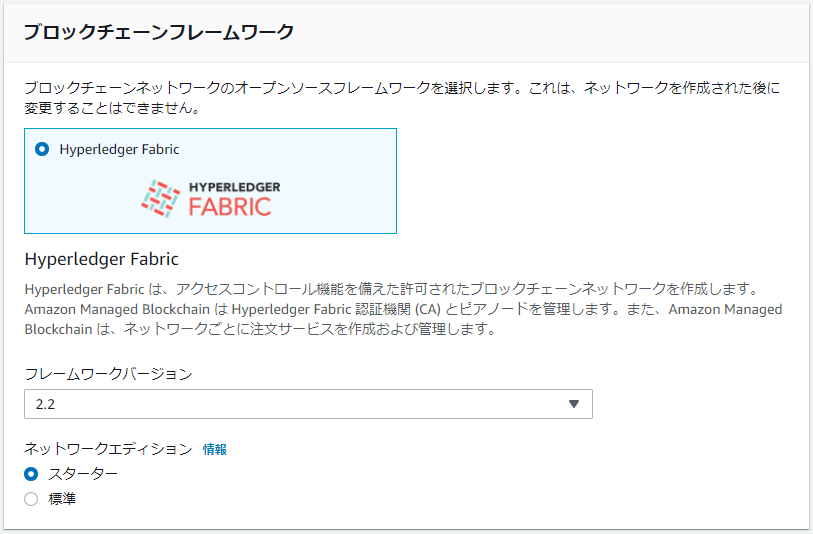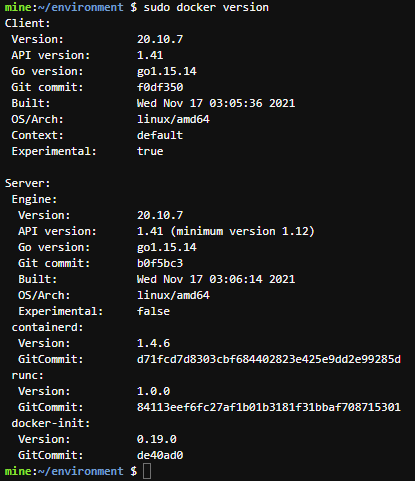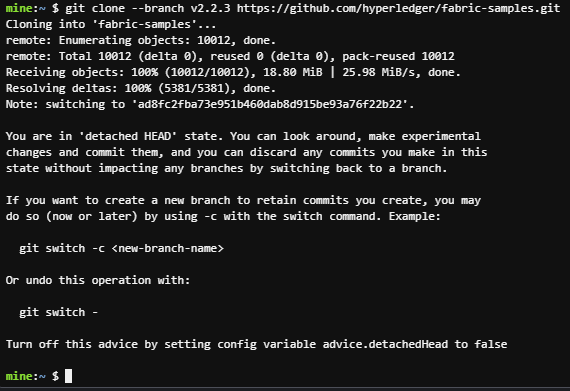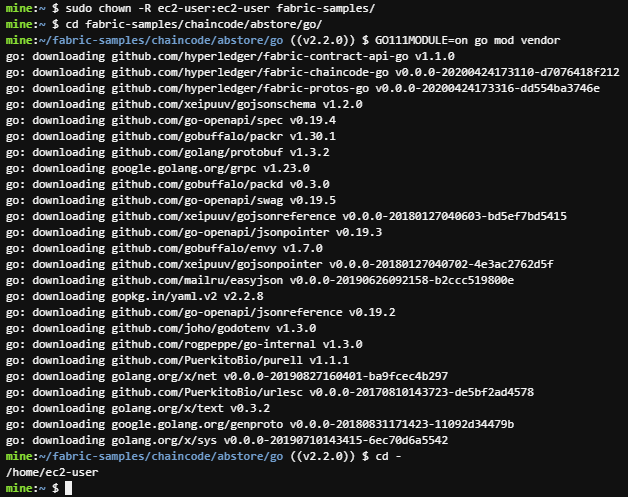以前、こちらの記事で、Amazon Managed Blockchain(Hyperledger Fabric)のハンズオン体験記を書いたが、フレームワークのバージョンが1.4でしか動かなかったため、今回2.2で確認しなおしてみました。
基本的には、こちらにある手順通りにやれば動くのですが、テキストベースでわかりづらいため、前回からの変更点をわかりやすく書いてみたいと思います。
またせっかくなので、今回はリージョンをバージニア北部(us-east-1)にしてみたいと思います。
(特に見えていませんが ^^;)
フレームワークのバージョン
クライアント(Cloud9)の設定
リージョンの設定
今回のバージョンの変更と関係ありませんが、リージョンも変更したので、一応載せておきます。
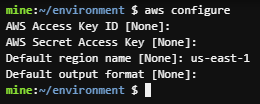
gitのインストール
新しい手順の方では、goをインストールした後に、再度gitをインストールしていますので、とりあえずやっておきます。
$ sudo yum install git -y
docker、docker-composeのバージョン
おそらく、最新のバージョンになっているかと思います。
以下のバージョン以上になっていれば良いそうです。
サンプルの取得
このあたりがちょっと違います。
新しいバージョン用のサンプルを取得します。
$ git clone --branch v2.2.3 https://github.com/hyperledger/fabric-samples.git
docker-composeの設定ファイル
こちらも使用するイメージのバージョンのところを修正する必要があります。
version: '2'
services:
cli:
container_name: cli
image: hyperledger/fabric-tools:2.2
tty: true
environment:
- GOPATH=/opt/gopath
- CORE_VM_ENDPOINT=unix:///host/var/run/docker.sock
- FABRIC_LOGGING_SPEC=info # Set logging level to debug for more verbose logging
- CORE_PEER_ID=cli
- CORE_CHAINCODE_KEEPALIVE=10
- CORE_PEER_TLS_ENABLED=true
- CORE_PEER_TLS_ROOTCERT_FILE=/opt/home/managedblockchain-tls-chain.pem
- CORE_PEER_LOCALMSPID=MyMemberID
- CORE_PEER_MSPCONFIGPATH=/opt/home/admin-msp
- CORE_PEER_ADDRESS=MyPeerNodeEndpoint
working_dir: /opt/home
command: /bin/bash
volumes:
- /var/run/:/host/var/run/
- /home/ec2-user/fabric-samples/chaincode:/opt/gopath/src/github.com/
- /home/ec2-user:/opt/home
バージョン以外は変わっていません。
(「MyMemberID」「MyPeerNodeEndpoint」の置き換えを忘れずに)
証明書の取得
こちらもバージョンとは関係ないですが、リージョンが変わりましたので、一応載せておきます。
aws s3 cp s3://us-east-1.managedblockchain/etc/managedblockchain-tls-chain.pem /home/ec2-user/managedblockchain-tls-chain.pem
チャンネル作成の設定ファイル
ここが大きく変わるところです。
################################################################################
#
# ORGANIZATIONS
#
# This section defines the organizational identities that can be referenced
# in the configuration profiles.
#
################################################################################
Organizations:
# Org1 defines an MSP using the sampleconfig. It should never be used
# in production but may be used as a template for other definitions.
- &Org1
# Name is the key by which this org will be referenced in channel
# configuration transactions.
# Name can include alphanumeric characters as well as dots and dashes.
Name: MemberID
# ID is the key by which this org's MSP definition will be referenced.
# ID can include alphanumeric characters as well as dots and dashes.
ID: MemberID
# SkipAsForeign can be set to true for org definitions which are to be
# inherited from the orderer system channel during channel creation. This
# is especially useful when an admin of a single org without access to the
# MSP directories of the other orgs wishes to create a channel. Note
# this property must always be set to false for orgs included in block
# creation.
SkipAsForeign: false
Policies: &Org1Policies
Readers:
Type: Signature
Rule: "OR('Org1.member')"
# If your MSP is configured with the new NodeOUs, you might
# want to use a more specific rule like the following:
# Rule: "OR('Org1.admin', 'Org1.peer', 'Org1.client')"
Writers:
Type: Signature
Rule: "OR('Org1.member')"
# If your MSP is configured with the new NodeOUs, you might
# want to use a more specific rule like the following:
# Rule: "OR('Org1.admin', 'Org1.client')"
Admins:
Type: Signature
Rule: "OR('Org1.admin')"
# MSPDir is the filesystem path which contains the MSP configuration.
MSPDir: /opt/home/admin-msp
# AnchorPeers defines the location of peers which can be used for
# cross-org gossip communication. Note, this value is only encoded in
# the genesis block in the Application section context.
AnchorPeers:
- Host: 127.0.0.1
Port: 7051
################################################################################
#
# CAPABILITIES
#
# This section defines the capabilities of fabric network. This is a new
# concept as of v1.1.0 and should not be utilized in mixed networks with
# v1.0.x peers and orderers. Capabilities define features which must be
# present in a fabric binary for that binary to safely participate in the
# fabric network. For instance, if a new MSP type is added, newer binaries
# might recognize and validate the signatures from this type, while older
# binaries without this support would be unable to validate those
# transactions. This could lead to different versions of the fabric binaries
# having different world states. Instead, defining a capability for a channel
# informs those binaries without this capability that they must cease
# processing transactions until they have been upgraded. For v1.0.x if any
# capabilities are defined (including a map with all capabilities turned off)
# then the v1.0.x peer will deliberately crash.
#
################################################################################
Capabilities:
# Channel capabilities apply to both the orderers and the peers and must be
# supported by both.
# Set the value of the capability to true to require it.
# Note that setting a later Channel version capability to true will also
# implicitly set prior Channel version capabilities to true. There is no need
# to set each version capability to true (prior version capabilities remain
# in this sample only to provide the list of valid values).
Channel: &ChannelCapabilities
# V2.0 for Channel is a catchall flag for behavior which has been
# determined to be desired for all orderers and peers running at the v2.0.0
# level, but which would be incompatible with orderers and peers from
# prior releases.
# Prior to enabling V2.0 channel capabilities, ensure that all
# orderers and peers on a channel are at v2.0.0 or later.
V2_0: true
# Orderer capabilities apply only to the orderers, and may be safely
# used with prior release peers.
# Set the value of the capability to true to require it.
Orderer: &OrdererCapabilities
# V1.1 for Orderer is a catchall flag for behavior which has been
# determined to be desired for all orderers running at the v1.1.x
# level, but which would be incompatible with orderers from prior releases.
# Prior to enabling V2.0 orderer capabilities, ensure that all
# orderers on a channel are at v2.0.0 or later.
V2_0: true
# Application capabilities apply only to the peer network, and may be safely
# used with prior release orderers.
# Set the value of the capability to true to require it.
# Note that setting a later Application version capability to true will also
# implicitly set prior Application version capabilities to true. There is no need
# to set each version capability to true (prior version capabilities remain
# in this sample only to provide the list of valid values).
Application: &ApplicationCapabilities
# V2.0 for Application enables the new non-backwards compatible
# features and fixes of fabric v2.0.
# Prior to enabling V2.0 orderer capabilities, ensure that all
# orderers on a channel are at v2.0.0 or later.
V2_0: true
################################################################################
#
# CHANNEL
#
# This section defines the values to encode into a config transaction or
# genesis block for channel related parameters.
#
################################################################################
Channel: &ChannelDefaults
# Policies defines the set of policies at this level of the config tree
# For Channel policies, their canonical path is
# /Channel/<PolicyName>
Policies:
# Who may invoke the 'Deliver' API
Readers:
Type: ImplicitMeta
Rule: "ANY Readers"
# Who may invoke the 'Broadcast' API
Writers:
Type: ImplicitMeta
Rule: "ANY Writers"
# By default, who may modify elements at this config level
Admins:
Type: ImplicitMeta
Rule: "MAJORITY Admins"
# Capabilities describes the channel level capabilities, see the
# dedicated Capabilities section elsewhere in this file for a full
# description
Capabilities:
<<: *ChannelCapabilities
################################################################################
#
# APPLICATION
#
# This section defines the values to encode into a config transaction or
# genesis block for application-related parameters.
#
################################################################################
Application: &ApplicationDefaults
# Organizations is the list of orgs which are defined as participants on
# the application side of the network
Organizations:
# Policies defines the set of policies at this level of the config tree
# For Application policies, their canonical path is
# /Channel/Application/<PolicyName>
Policies: &ApplicationDefaultPolicies
LifecycleEndorsement:
Type: ImplicitMeta
Rule: "ANY Readers"
Endorsement:
Type: ImplicitMeta
Rule: "ANY Readers"
Readers:
Type: ImplicitMeta
Rule: "ANY Readers"
Writers:
Type: ImplicitMeta
Rule: "ANY Writers"
Admins:
Type: ImplicitMeta
Rule: "MAJORITY Admins"
Capabilities:
<<: *ApplicationCapabilities
################################################################################
#
# PROFILES
#
# Different configuration profiles may be encoded here to be specified as
# parameters to the configtxgen tool. The profiles which specify consortiums
# are to be used for generating the orderer genesis block. With the correct
# consortium members defined in the orderer genesis block, channel creation
# requests may be generated with only the org member names and a consortium
# name.
#
################################################################################
Profiles:
OneOrgChannel:
<<: *ChannelDefaults
Consortium: AWSSystemConsortium
Application:
<<: *ApplicationDefaults
Organizations:
- <<: *Org1
(2ヶ所の「MemberID」の置き換えを忘れずに)
チェーンコードの登録
ここが全然違います。
手順を追って進めていきます。
ベンダーの依存関係のインストール
今回は「abstore」というサンプルのチェーンコードを使用します(前回の「chaincode_example02」は無くなっている)が、それが呼び出すモジュール類をインストールします。
$ sudo chown -R ec2-user:ec2-user fabric-samples/
$ cd fabric-samples/chaincode/abstore/go/
$ GO111MODULE=on go mod vendor
$ cd -
チェーンコードパッケージを作成
使用するチェーンコードをtar.zipにまとめます。
$ docker exec cli peer lifecycle chaincode package ./abstore.tar.gz \
--path fabric-samples/chaincode/abstore/go/ \
--label abstore_1
パッケージをインストール
まとめたtar.zipをインストールします。
$ docker exec cli peer lifecycle chaincode install abstore.tar.gz
パッケージを確認
ちゃんとインストールできたか、確認します。
$ docker exec cli peer lifecycle chaincode queryinstalled
チェーンコードを承認
まず、環境変数に、先ほどのパッケージIDを登録しておきます。
$ export CC_PACKAGE_ID=abstore_1:3918d0438fd2ebe48ed1bde01533513a14f788846fd2d72ef054482760e73409
その後、チェーンコードの承認を行います。
$ docker exec cli peer lifecycle chaincode approveformyorg \
--orderer $ORDERER --tls --cafile /opt/home/managedblockchain-tls-chain.pem \
--channelID mychannel --name mycc --version v0 --sequence 1 --package-id $CC_PACKAGE_ID
コミットの準備状況を確認
ここでチェーンコードの準備状況を確認します。
$ docker exec cli peer lifecycle chaincode checkcommitreadiness \
--orderer $ORDERER --tls --cafile /opt/home/managedblockchain-tls-chain.pem \
--channelID mychannel --name mycc --version v0 --sequence 1
チェーンコードをコミット
最後にチェーンコードをコミットします。
$ docker exec cli peer lifecycle chaincode commit \
--orderer $ORDERER --tls --cafile /opt/home/managedblockchain-tls-chain.pem \
--channelID mychannel --name mycc --version v0 --sequence 1
チェーンコードを確認
もう一度チェーンコードを確認します。
$ docker exec cli peer lifecycle chaincode querycommitted \
--channelID mychannel
チェーンコードの実行
ここも微妙に変わっていますので、順に追っていきます。
チェーンコードを初期化
チェーンコードの初期化を行います。
初期値として「a」に100、「b」に200を設定します。
$ docker exec cli peer chaincode invoke \
--tls --cafile /opt/home/managedblockchain-tls-chain.pem \
--channelID mychannel \
--name mycc -c '{"Args":["init", "a", "100", "b", "200"]}'

ちゃんと初期化できていれば、statusで200が返ってきます。
チェーンコードを照会
「a」の値を確認します。
$ docker exec cli peer chaincode query \
--tls --cafile /opt/home/managedblockchain-tls-chain.pem \
--channelID mychannel \
--name mycc -c '{"Args":["query", "a"]}'
チェーンコードを呼び出す
「a」から「b」に「10」送金してみます。
$ docker exec cli peer chaincode invoke \
--tls --cafile /opt/home/managedblockchain-tls-chain.pem \
--channelID mychannel \
--name mycc -c '{"Args":["invoke", "a", "b", "10"]}'
念のため、「a」の値を確認してみます。
$ docker exec cli peer chaincode query \
--tls --cafile /opt/home/managedblockchain-tls-chain.pem \
--channelID mychannel \
--name mycc -c '{"Args":["query", "a"]}'
まとめ
変更のポイントは以下になるかと思います。
- サンプルのバージョンを変更
- dockerイメージのバージョンの変更
- チャンネル設定ファイル(configtx.yaml)の記述の変更
- チェーンコードの登録/実行方法の変更
